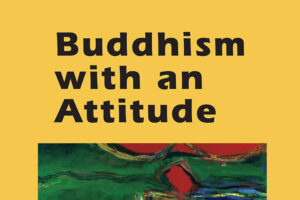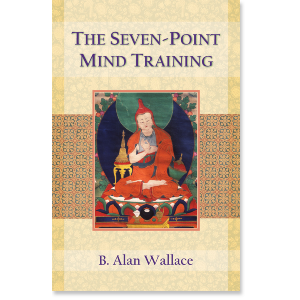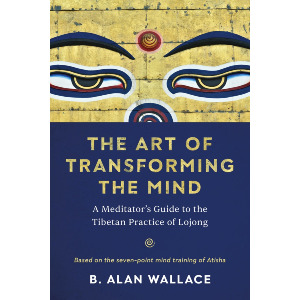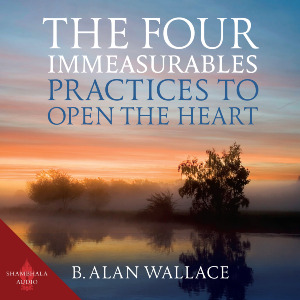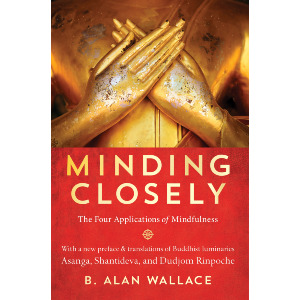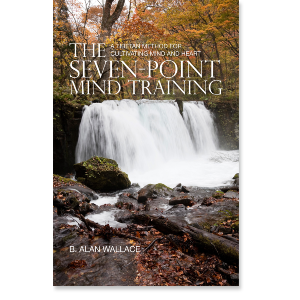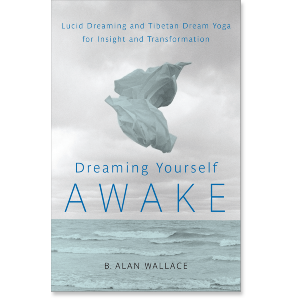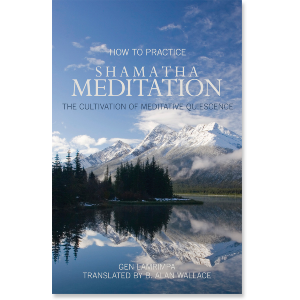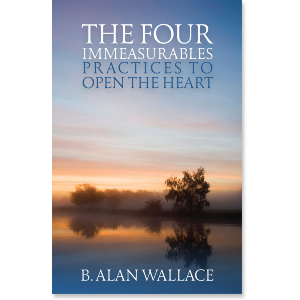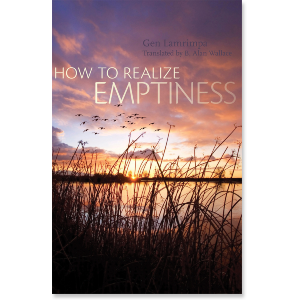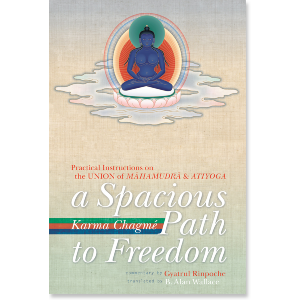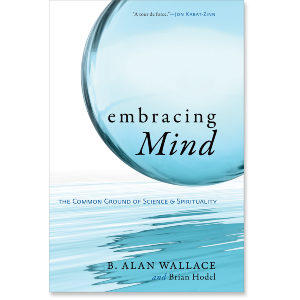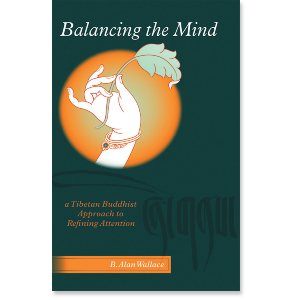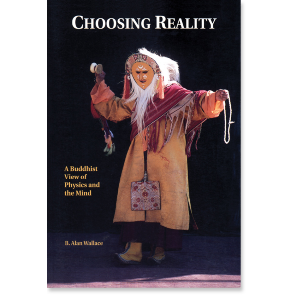| The following article is from the Summer, 2003 issue of the Snow Lion Newsletter and is for historical reference only. You can see this in context of the original newsletter here. |
How can having an attitude help us?
All of us have attitudes. Some of them accord with reality and serve us well throughout the course of our lives. Others are out of alignment with reality, and cause us problems. Tibetan Buddhist practice isn't just sitting in silent meditation, it's developing fresh attitudes that align our minds with reality. Attitudes need adjusting, just like a spinal column that has been knocked out of alignment. B. Alan Wallace explains a fundamental type of Buddhist mental training called lojong, which can literally be translated as attitudinal training. It is designed to shift our attitudes so that our minds become pure well-springs of joy instead of murky pools of problems, anxieties, fleeting pleasures, hopes and frustrations. Wallace brings this centuries-old practice into the twenty-first century.
An excerpt from Buddhism with an Attitude
In the early 1970's, a friend of mine complained to the Dalai Lama about how difficult it is to become enlightened in such a degenerate time as ours. This has been a familiar refrain throughout the history of Buddhism, with just about every generation referring to its own era as a degenerate time. But the Dalai Lama's response cut him short. He told him that the only reason so few people attain enlightenment these days is that they are not practicing with the same diligence as the great adepts of the past. If people were to practice today with the same dedication as such great contemplatives as the Tibetan yogi Milarepa, they would achieve the same results, regardless of how- degenerate their times are.
A key element in realizing the potential of our precious human life of leisure and opportunity is faith. Faith is also a prerequisite for a successful career. If you don't have faith in your chosen field, physics for example, it will be difficult to complete a Ph.D. As in many endeavors, in science it is necessary to take many things, such as research outside your specialty, on well-grounded faith. Well-grounded faith in our potential for wisdom, compassion, and power is an important part of what Buddhists mean by opportunity. Another type of faith, blind faith that has no basis in reality, is useless at best.
The preciousness of life is having time and circumstances to fulfill what Tsongkhapa, a great fifteenth-century Tibetan Buddhist contemplative, called our eternal longing. This is a very significant statement because the Buddhist meaning of eternal includes all previous lifetimes, a very long time. The Seven-Point Mind-raining advises us to recognize right at the beginning our opportunity and potential. Also, be effective; don't get sidetracked. In this life, you have a precious opportunity to fulfill your eternal longing to find genuine happiness.
...if you believe happiness is out there in a religious tradition or with your teacher or in the spiritual community, you are missing the point. Dharma consists of methods to unveil what is already within you.
The meaning of "rare" in Buddhist cosmology
Leisure and opportunity are precious and rare. The Buddhist meaning of rare is based on Buddhist cosmology, which in some respects is similar to modern astronomy concerning the size and age of the cosmos. Western astronomers speak of solar systems, galaxies, galaxy clusters, and galaxy super-clusters. Western astronomers attempt to pinpoint the date of the Big Bang, one estimate being thirteen billion years ago. Buddhist cosmology agrees in principle with the theory of the universe oscillating between cycles of Big Bang/development/Big Crunch, another Big Bang/development/Big Crunch, but it places the history of our present universe at considerably longer than thirteen billion years.
The Buddhist meaning of rare is embedded in the Buddhist cosmological worldview. Within the vast, oscillating billion-fold world systems inhabited by sentient beings, Buddhists speak of six different modes of sentient life, each with a different range of experience. Some beings have incredible misery, some incredible bliss. Human beings have the widest spectrum of experience extending from misery to bliss. Hell and heaven, it is all here, giving rare a special meaning.
Within this cycle of existence, rebirth after rebirth, extending back through immeasurable time in an infinite cycle of universes, there are rare occasions when we rise to a human rebirth of leisure and opportunity. The Buddha used a metaphor to exemplify the rarity of a precious human life of leisure and opportunity: Imagine a tortoise swimming submerged in a vast ocean and resurfacing only once every one hundred years. The times of human rebirth are similar to the infrequent times the tortoise comes up for air. Now imagine an ox's yoke floating on the same ocean. Consider the tortoise's chances of poking his head through the yoke when he comes up for air every hundred years. This is the meaning of rarity in rare and precious human life of leisure and opportunity. The object of discursive meditation on the rare opportunity of a precious human life of leisure and opportunity is to motivate us to use our rare opportunity wisely.
There is another layer of meaning here which addresses basic assumptions about our life. Just as Buddhist cosmology describes the outer world as infinite in space and time, Buddhists also describe human potential, the inner world, as infinite. Lama Yeshe, a fine Tibetan Buddhist teacher who passed away some years ago, used to tell this parable to his Western students: You are like beggars living in a shack, ignoring your poverty. Meanwhile, just under the dirt floor, there is a treasure of immeasurable value. You just need to scrape off the dust and you will find it.
The treasure is really within your own mind and heart. Teachers, traditions, techniques, all have the single purpose of helping unveil that which is already within you. If you think otherwise, if you believe happiness is out there in a religious tradition or with your teacher or in the spiritual community, you are missing the point. Dharma consists of methods to unveil what is already within you.
The preliminaries require us to examine our basic assumptions about the nature of life and its potential. This examination shifts the focus of attention and shakes loose preconceptions. Buddhists aren't alone in realizing the crucial importance of focus and attention in the quest for well-being and psychological balance. William James, the eminent American psychologist, said at the end of the scientifically over-confident nineteenth century, our belief and attention are the same fact. For the moment, what we attend to is reality... When you begin to attend to facets of reality uncovered by discursive meditation, when you notice, for example, that your opportunity for realizing your innate human potential is very rare and precious, the practice of Dharma begins to flow naturally from your heart. Tibetan lamas emphasize the importance of this life by advising their students, If you have a precious human life of leisure and opportunity, use it well. If you don't have one, get one.
B. Alan Wallace has authored, translated, edited, and contributed to more than forty books on Tibetan Buddhism, science, and culture. With fourteen years as a Buddhist monk, he earned a BA in physics and the philosophy of science and then a PhD in religious studies. After teaching in the Department of Religious Studies at the University of California, Santa Barbara, he founded the Santa Barbara Institute for Consciousness Studies to explore the integration of scientific approaches and contemplative methods.


